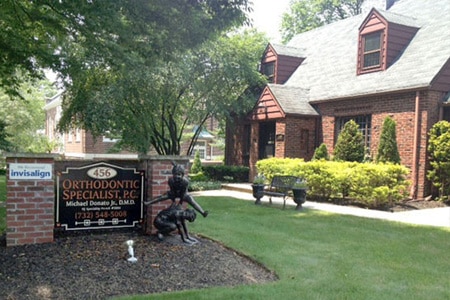Early Treatment
Invisalign First
Invisalign First is an aligner program designed for a positive treatment experience for younger children who are eligible for orthodontic treatment. It is formulated to address the unique needs of growing children- aligning their teeth while expanding their arches and making room for existing teeth and incoming permanent teeth.
Lip Bumper Therapy
Your lip bumper is a very important part of your orthodontic treatment. The lip bumper appliance is designed to gain space and make room for your lower teeth. It does this by moving your molars toward the back of your mouth or allowing the front teeth to drift forward. In some cases, the bumper is used to stop a lower lip contraction habit thus allowing the lower teeth to align. At first, the appliance will be tied in and not be able to be removed. In time Doctor Donato may untie the bumper allowing it to come out for brushing. At some point, you will be asked to wear the bumper nights only. This is done to maintain the correction you gained during full-time wear.
WHAT TO EXPECT
At first, the bumper will feel very strange against your lower lip. You may notice your lip plumps out a little. As time goes on and your teeth move back you lip will flatten out. The back teeth that have the bands may become sore or tender for a few days, following an adjustment. This will subside and the appliance will feel fine. While the bumper is tied in, food may become lodged between the bumper and your lower teeth and gums. When the doctor unties it, brushing becomes much easier.
Do’s
- Wear the lip bumper full time (including eating and sleeping).
- Brush around the bands and bumper very well.
- When the appliance is untied by the doctor, brush the bumper, teeth and gums underneath very well.
- At the time the doctor starts you on nights only you must not forget to wear it every night or all of the hard work you achieved while wearing it full time will be lost. If you miss a night wear it the next day to make up for the lost night.
- Use Tylenol or other pain relieving medication for the first couple of days if necessary.
Don’ts
- Do not chew gum, taffy, or sticky candy while you have your bumper and bands in your mouth.
- Do not twist or pull the bumper out unevenly. This may loosen the bands. Gently wiggle it, pulling it forward.
- Do not leave it out of your mouth for any reason. You will lose all of the tooth movement you may have gained.
Fixed Expander
Distalizing Appliance***
Lorem ipsum dolor sit amet, consectetur adipiscing elit. Ut elit tellus, luctus nec ullamcorper mattis, pulvinar dapibus leo.
Removable Expanders
The removable appliance is a very important part of your treatment. It is an extremely precise and custom piece of equipment that requires excellent care and attention. Removable appliances include retainers, activators, expanders and bite plates, and are made from a detailed impression and model to fit only your mouth. Because they cannot be mass-produced they are hand-made by expert orthodontic lab technicians which require a new impression for each appliance. These appliances can be delicate and are expensive to replace so please handle them carefully.
What to Expect
When you get a new appliance it will feel very clumsy and strange in your mouth. Initially speaking, eating, drinking, and swallowing will feel impossible. You must leave the appliance in for everything you do! If you take it out you will never get used to it. The break-in period is usually about 2-3 days, then it will feel fine.
Do’s
- Wear it 24 hours/7 days a week. Remove it only for brushing or to wear a mouthguard during sports. Eat and sleep with it.
- Clean it with your toothbrush and toothpaste carefully. You can also use Retainer Brite tablets, denture cleaning tablets, or soap and water if it falls on the floor.
- If it has a screw to expand do not forget to turn it with your key as prescribed. The tightness will go away quickly.
- Use Tylenol or other pain relieving medication for the first couple of days if necessary.
Don’ts
- Never boil or submerge it in very hot water. It will lose its shape and fit.
- Never place it in anything other then your retainer case. It will become lost or broken that way.
- If it cannot be worn for some reason, never stop wearing it. Whatever was accomplished will be lost and the appliance may lose its fit, requiring a new one to be made. Wear the appliance at least part-time (nights only) if there is a problem. This will maintain its fit until you can get into the office to have the problem taken care of.
Lost or broken Phase I appliances will result in a replacement fee of $290.00.
If you have any questions regarding orthodontic appliances, please call Orthodontic Specialist, PC today.
Habit Appliance
Facemasks
Comprehensive Treatment Add-Ons
Forus Springs***
Lorem ipsum dolor sit amet, consectetur adipiscing elit. Ut elit tellus, luctus nec ullamcorper mattis, pulvinar dapibus leo.
TADs
Temporary Anchorage Device (TAD)
Temporary anchorage devices, or TADs, are small titanium anchors used in some orthodontic cases to help achieve tooth movement more quickly, efficiently, and with as much comfort as possible. TADs are used to help straighten teeth in situations where braces alone are not enough. TADs are also used as an alternative to headgear.
How does Dr. Donato place a TAD?
TADs are placed without the use of a needle. A strong anesthetic is used to numb the gum tissue and the jaw surrounding the area where the TAD will be placed. Once the area is numb, Dr. Donato gently places the TAD through the gum tissue and firmly into the jawbone. The placing of a TAD is quick, with very little to no pain. You may feel a slight pressure as Dr. Donato placed the TAD; however, within a day, you will no longer be able to feel the TAD. Your TAD is removed once your treatment is complete, or when it is no longer needed to help straighten your teeth. Removal of a TAD takes just minutes and is completely pain-free.
What can I do to relieve any discomfort caused by my TAD?
If you do feel any discomfort from having your TADs placed, Tylenol or Ibuprofen is recommended to help relieve your pain. If you continue to experience discomfort days after your treatment, please contact Dr. Donato as soon as possible.
How can I keep my TAD clean?
A TAD can be cleaned the same way you clean your braces, by brushing your teeth at least three times a day. When you get your TAD placed, we will also provide you with an antimicrobial mouthwash that you will need to use twice a day.
If you have questions about TADs, please contact our practice. Dr. Donato will be able to answer any of your questions and provide you with detailed information about your orthodontic treatment with a TAD. Please call or click here to schedule an appointment today.
Fixed Bite Openers
The fixed bite plate is a very important part of your orthodontic treatment, if needed. It is cemented to your teeth to protect your lower braces and reduce the depth of your bite. This appliance will allow your back teeth to grow while it holds your front teeth. Dr. Donato will remove it after several months when the correction is achieved.
What to Expect
At first the bite plate feels strange on the roof of your mouth. You will feel some tightness against your side and back teeth. These teeth may feel sore or tender for 2-3 days following the placement of the appliance. Eat gently on these teeth until they feel better. Your tongue may develop grooves in it from resting against the appliance, these will disappear when it is removed. Most importantly your back teeth will not touch each other temporarily. You will have to eat gently on your front teeth only. Eventually, the back teeth will begin to touch again. Your speech will be different for a couple of days and then will quickly return to normal.
Do’s
- Brush the appliance when you brush your teeth.
- Rinse out if you cannot brush to remove food that may get lodged in the appliance.
- Use Tylenol or other pain relieving medication for the first couple of days.
- Use PhosFlur once a day to protect the teeth covered by plastic.
Don’ts
- Do not chew gum, taffy, or sticky candy while you have your bite plate.
- Do not pull, bend, or pry your bite plate, this may cause it to angle downward and get in your way.








